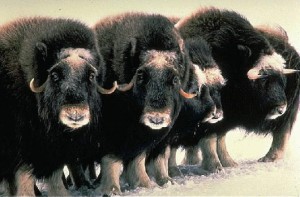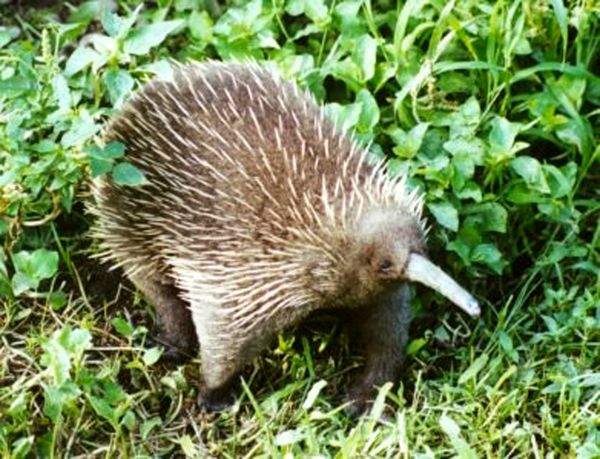As we face the uncertain effects of climate change ourselves in the future it is instructive to look back in time to see how other species fared. (See also a geologic perspective on the effects of climate change.) Paleontology is one of the main sciences involved in this research and so proves to be very relevant to this modern issue.
A recurring mystery in paleontology is the cause of the most recent major extinction event at the end of the Pleistocene or Ice Age. Many large species of mammals, collectively referred to as megafauna, became extinct relatively recently, a mere 10,000 years ago more or less. Charismatic animals such as mammoths, mastodons, giant ground sloths, and saber toothed cats vanished from the Earth forever.
It has long been debated what the primary cause of this extinction event was. Just as with other major extinctions observed in the fossil record, there are a number of suspected causes for Ice Age extinctions: disease, climate changes, and extra-terrestrial phenomena like asteroids. But the Ice Age extinctions have another factor that previous extinction events do not have—the emergence of humans as a major player upon the landscape. Did human activities, maybe the over hunting of the megafauna, drive them to extinction?
Many studies have tried to get at this question, but it is very difficult to separate all the confounding issues from each other to focus on just one to test its potential effects. A new study however was able to do just this.
In a recent paper (Campos et al., 2010) DNA material was extracted and analyzed from one of the species that did survive the Ice Age extinctions, the musk oxen. This Ice Age relic lives today mainly in the high-latitudes of Greenland and Canada, but was once more wide-spread. Indeed, its remains have even found as far south as Nebraska, New York, and Ohio during the Pleistocene.

Musk oxen are well adapted to the extremes of arctic living with sturdy bodies and thick coats of hair.
The researchers collected samples from across the musk oxen’s former range for the last 60,000 years. They examined the DNA to look for patterns of population dynamics over that period. Basically, when a population is strong and has many members the DNA samples show an increase in diversity—more genetic variation in the mix. When populations suffer and numbers decrease the results show up in the DNA as a decrease in diversity, sometimes referred to as a genetic bottleneck. So, the DNA diversity over time shows a proxy for population numbers and health.
Therefore, if humans were a prime driver of population declines for musk oxen at the end of the Ice Age we would expect to see genetic bottlenecks within the DNA corresponding to the timing of human activity within the musk oxen’s range.
The DNA results show that the geographic origin of all the musk oxen DNA is northeast Siberia with a large diverse population. However, the population in that region crashed about 45,000 years ago. After that population decline, there was a world-wide genetic diversity increase about 30,000 years, followed by another decline about 18,000 years ago, and finally a slight recovery about 5,000 years to the modern relict populations.
With these data we can directly test for the first time the correlation of population declines of the musk ox with human activity. And, in fact, they do not correlate very well, suggesting that humans played little role in the population dynamics of musk oxen.
So, if not humans, what then was driving the populations to decline? The most likely cause was environmental changes, particularly climate changes. The Pleistocene is characterized by shifts in climate patterns with the best-known effect being glacial advance and retreat over the last 2 million years. It seems, at least in the case of musk oxen populations, that the pattern of boom and bust was driven by their ability to adapt to climatic changes in their environment. Musk oxen almost went the way of the mammoths and succumbed fully to extinction, but managed to just hold on by their horns in greatly reduced numbers until today.
Of course, whether they, or any other species that are similarly at risk, will weather the next several decades, and any modern climate changes, remains to be seen. The effects of climate change may well prove to be too much for them after all.
CAMPOS, P. F., E. WILLERSLEV, A. SHER, L. ORLANDO, E. AXELSSON, A. TIKHONOV, K. AARIS-SØRENSEN, A. D. GREENWOOD, R.-D. KAHLKE, P. KOSINTSEV, T. KRAKHMALNAYA, T. KUZNETSOVA, P. LEMEY, R. MACPHEE, C. A. NORRIS, K. SHEPHERD, M. A. SUCHARD, G. D. ZAZULA, B. SHAPIRO, AND M. T. P. GILBERT. 2010. Ancient DNA analyses exclude humans as the driving force behind late Pleistocene musk ox (Ovibos moschatus) population dynamics. Proceeding of the National Academy of Sciences.



